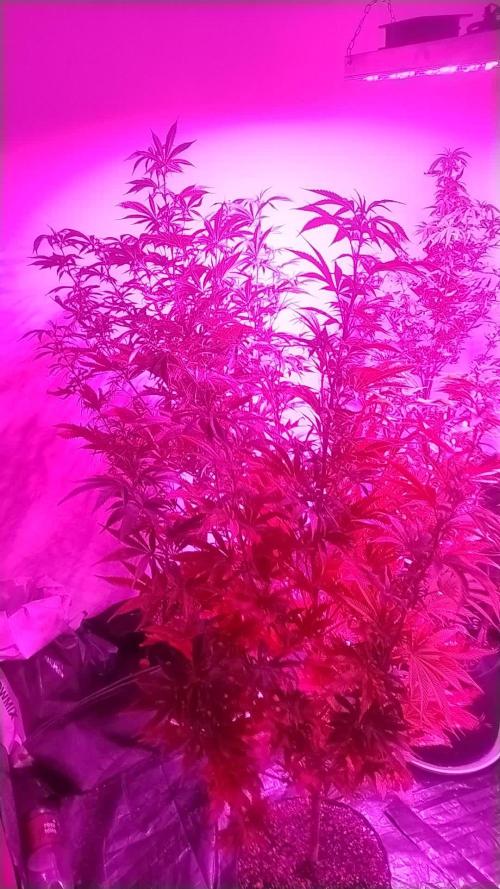The Grow Awards 2026 🏆 

























Likes
1
Share


@Dr_Med_Rasen
Follow
Hey,
just wanted to show my little experiment. A selfmade grow bucket. Lemon Cherry Cookies Auto by Fastbuds. Plant is 4 Weeks old now, was in soil before in a 1L Pot. Changed to Hydro because other plants having trouble with my ph or magnesium problems. I dont know. Because my last grow in this bucket went pretty well i tried to give it another chance before i buy myself a better dwc system with more buckets.
👉Update Day 32
Removed 2 large leaves to give the shoots underneath more access to light.
Also added an AC Infinity 60x60 SCROG net and set it up in a way that the lower shoots give the upper ones more space, allowing them to get better light exposure.
------------German----------
Hey,
wollte nur mein kleines Experiment zeigen. Ein selbstgebauter DWC-Kübel, bestehend aus nem Airpot, nem Eimer und ner Aquariumpumpe mit Luftstein. Dazu noch n günstiger Füllstandsanzeiger von Amazon.
Lemon Cherry Cookies Auto von Fastbuds. Die Pflanze ist jetzt 4 Wochen alt, war vorher in Erde in einem 1L Topf. Bin auf Hydro umgestiegen, weil andere Pflanzen Probleme mit meinem ph-Wert oder Magnesiumprobleme hatten. Ich weiß es nicht. Da meine letzter Grow in diesem Bucket gut lief wollte ich DWC eine weitere Chance geben, bevor ich mir ein besseres System kaufe.
👉Update Tag 32
2 große Blätter mehr entfernt um den Trieben darunter mehr Licht zur Verfügung zu stellen.
Zudem noch ein AC Infinity 60x60 Scrognetz bekommen und so gespannt dass die unteren Triebe die oberen etwas freier stehen lassen und diese sich besser mit Licht versorgen können.
Likes
9
Share


@crystal_garden_0
Follow
Great week 100% germination rate and all the girls are out of the soil ready to start life. Haven't found a Bubble gum strain like the real one, let's hope this is it. So far FastBuds description of their Autoflowers has been spot on . Thanks everyone. You can see these on YT also if intrested, thanks everyone
Likes
17
Share


@420DeepGrow
Follow
Gracias al equipo de Seedsman Marshydro XpertNutrients y Trolmaster sin ellos esto no sería posible.
💐🍁 Tangerine Snow F1 Fast:
Esta gran cepa es un cruce de cuatro vías 75% sativa de (Boost x Tangelo) con (Lavender x Power Plant). Este híbrido Fast F1 proviene de la genética Cali y cuenta con excelentes terpenos cítricos, alta producción de resina para extractos, altos niveles de THC, muy buenos rendimientos y excelente resistencia al moho. Tangerine Snow F1 Fast se puede cultivar tanto en interior como en exterior. Los tiempos de floración en interiores son de entre 8 y 10 semanas, mientras que el tiempo de cosecha en las latitudes del norte es en septiembre, mientras que en el hemisferio sur los productores cosecharán durante marzo. Las regiones climáticas recomendadas son cálidas, secas, húmedas y cálidas. Se trata de plantas altas, semiramificadas, que superan los 200cm y que presentan un alto vigor con muy buena uniformidad. Al igual que muchas otras variedades con fuerte dominancia sativa, Tangerine Snow F1 Fast ofrece una excelente resistencia al moho, así como a las plagas y enfermedades de las plantas. La combinación de terpenos cítricos y mucha resina la convierten en una cepa de muy buen extracto, cuyo método de "lavado" produce muy buenos rendimientos de hachís. El perfil de terpenos cítricos recuerda a las mandarinas y mandarinas y también tiene notas dulces. La producción de THC ha sido verificada en laboratorio en un fuerte 24%, mientras que el CBD es bajo. El efecto es edificante y energizante, perfecto para usar durante el día y las primeras horas de la noche.
🌻🚀 Consigue aqui tus semillas:
💡TS-3000 + TS-1000: se usaran dos de las lámparas de la serie TS de Marshydro, para cubrir todas las necesidades de las plantas durante el ciclo de cultivo, uso las dos lámparas en floracion para llegar a toda la carpa de 1.50 x 1.50 x 1.80.
https://marshydro.eu/products/mars-hydro-ts-3000-led-grow-light/
🏠 : Marshydro 1.50 x 1.50 x 1.80, carpa 100% estanca con ventanas laterales para llegar a todos los lugares durante el grow
https://marshydro.eu/products/diy-150x150x200cm-grow-tent-kit
🌬️💨 Marshydro 6inch + filtro carbon para evitar olores indeseables.
https://marshydro.eu/products/ifresh-smart-6inch-filter-kits/
💻 Trolmaster Tent-X TCS-1 como controlador de luz, optimiza tu cultivo con la última tecnología del mercado, desde donde puedes controlar todos los parametros.
https://www.trolmaster.com/Products/Details/TCS-1
🍣🍦🌴 Xpert Nutrients es una empresa especializada en la producción y comercialización de fertilizantes líquidos y tierras, que garantizan excelentes cosechas y un crecimiento activo para sus plantas durante todas las fases de cultivo.
Consigue aqui tus Nutrientes:
https://xpertnutrients.com/es/shop/
📆 Semana 3:
Ha sido una buena semana, ella ha dado un gran cambio en su lugar definitivo 😎.
Se le ha aplicado un tratamiento insecticida con agua + tierra de diatomeas ( 1 cucharadita por litro de agua), también se le aplica un tratamiento fungicida con una infusión de cola de caballo para evitar futuro moho.
A partir de ahora se aplica riego por goteo, 1/3 de la dosis recomendada por el fabricante ya que al estar en exterior y en buena tierra tiene bastante comida.
En interior se riega manualmente con dosis de nutrientes recomendadas por el fabricante.
Likes
8
Share


@ThePiney_grower
Follow
2 week of flower
Not very satisfied for the sensi seed plant
Dutch passion and medical seeds are Amazing
Likes
47
Share


@AsNoriu
Follow
Day 85 since seed touched soil.
Trim jail !!!
More than 2 meters of hanging buds , a bit airy, but amazingly smelly !!!
Happy Growing !!!
Likes
10
Share


@HideAndFly420
Follow
Day 34 this lady is running, I can see flowers getting bigger every day, smell started really really soon this time so I already had to add the Carbon Filter.
I’d like to close the cycle in less then 80 days. It would be great
First flowering fertilisation
Ph 6.2
Ppm 631
Day 37 - 9 of flower 🌸
Started blooming fertilisation, I’m keep Giving all-in one from aptus, i think I lm substitute with super pk and I stop all in one.
Ph 6.2
Ppm 731
As I’m growing an solito in a 9.2 lt pots with all mix nutrients I’m slowing down with all in one and just giving base feedings, I ll decide later if I should give super-pk for the next weeks
Day 40, tomorrow will be feeding days. Sge’s going really well, resin is already showing up on flowers that are several as and colorfull, smell is already there 🤤
Tomorrow update with feedings parameters.
Day 41 feeding day
Aptus regulator 0,15ml/1 lt
Aptus all in one 1,25ml/1lt
Aptus Topbooster 0,3 ml
Aptus enzym + 0,5 ml
Calmag 0,3 ml /L
Ph 6,18
Ppm 756
Let’s see
Likes
18
Share


@Roberts
Follow
Zealix is growing good. Sorry I missed many weeks due to hand surgery. Then gd was having site issues with updates. Hopefully everything is fixed now. I did a solution changed a few days ago. She is in need of some heavy defoliation very soon. She is reaching her maturity now. I will be switching her and the other plant from Terpyz over to flowering soon. Everything is looking good now. Thank you Terpyz Mutant Genetics, and Medic Grow. 🤜🏻🤛🏻🌱🌱🌱
Thank you grow diaries community for the 👇likes👇, follows, comments, and subscriptions on my YouTube channel👇.
❄️🌱🍻 Happy Growing 🌱🌱🌱
https://youtube.com/channel/UCAhN7yRzWLpcaRHhMIQ7X4g.
Likes
12
Share


@SparkSupertramp
Follow
So far so good, I guess.
I think magnesium deficiency in some plants but I’m not quite sure yet.
I have plan to feed some nutrients in next few days.
And I’m really looking for some suggestion and that would be my pleasure.
Likes
30
Share


@coyote2thick
Follow
I’m lightly defoliating each and making sure my bud sites are exposed. Everything seems to be swelling up nicely.
Likes
229
Share


@Crashoverite
Follow
Hi everyone 😁
Welcome back in another week update!
Have to say girls are looking stunning 😍 frost it's almost everywhere. Trichomes on some buds up to 30% amber and progressing by hour. They are gaming weight on buds nicely as well. Aroma OMG I am sensing ripe sweet fruits, a bit woody and gasy. Planning to turn the lights off on Thursday at midnight and harvest by Sunday 😅
Wishing everyone a great week
Stay tuned for daily updates
Peace and love brothers and sisters ✌️💚
02/10 Day 71
Watered again approx. 2.5l of water and fish shit at 0.4 ml per 1 ltr. Runoff approx. 50-100ml.
04/10 Day 73
Everything going great. More amber trichomes, almost all pistils hairs are brown. These girls are almost ready. The Day it's just around the corner.
05/10 Day 74
Last watering, in the morning approx. 1.5l per pot. At midnight lights out for good.
06/10 Day 75
Uploaded 2 clips from last night.
Trichomes are on point. Some buds 50-70% amber and they did gained some weight overnight. Just one more night of darkness and will harvest! 😎
07/10 Day 76
It's done!!! Harvested and trimmed.
Soon will return with final update - Harvest 😁
Thank you all for such a great support, likes comments and pm's
Peace and love brothers and sisters ✌️💚
Likes
21
Share


@PeterSage
Follow
wonderfull colours and smell, plant is looking fine, i see another 2/3 weeks from now, for a full development of the buds.
heavy and frequent rain occurring, didn't have to water so much, hope it get better from here to the cut.
i am gonna decrease on the nutrients, to make them disappear in 10-15 days and a have a full week on just pure water.
the quality of the smell is incredible, very sugar-candy like, not so citric.
Processing
Likes
6
Share


@OleGrow
Follow
11-Nov:
Topped up the soil with 15ml of Gaia Green All Purpose 4 4 4.
13-Nov:
Trimmed leaves that weren't getting any light
Likes
6
Share


@LX1977
Follow
J29 arrosage avec engrais (1,5 litre/plantes)
La floraison a bien commencée, pas de signe de carence ni d'excès. Tout se passe au mieux 👍
J31 arrosage eau (500ml/plantes)
J32 arrosage avec engrais 1,5 litre/plantes)
J34 arrosage eau (1,5 litre/plantes)































